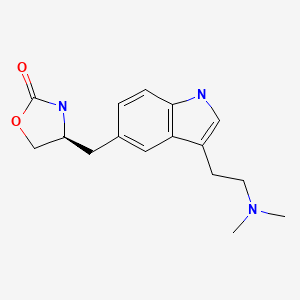Attribution Statement: LactMed is a registered trademark of the U.S. Department of Health and Human Services.
NCBI Bookshelf. A service of the National Library of Medicine, National Institutes of Health.
Drugs and Lactation Database (LactMed®) [Internet]. Bethesda (MD): National Institute of Child Health and Human Development; 2006-.
CASRN: 139264-17-8

Drug Levels and Effects
Summary of Use during Lactation
Preliminary evidence indicates that zolmitriptan levels in breastmilk are low. Amounts ingested by the infant are small and unlikely to affect the nursing infant, especially if the infant is older than 2 months. Concurrent use of propranolol might increase the zolmitriptan dose received by the breastfed infant substantially. Painful, burning nipples and breast pain have been reported after doses of sumatriptan and other triptans. This has occasionally been accompanied by a decrease in milk production.
Drug Levels
Zolmitriptan is metabolized to the active metabolite, N-desmethylzolmitriptan by CYP1A2 and CYP3A4.
Maternal Levels. Four women who were at least 1 month postpartum used zolmitriptan to treat migraine provided one milk sample before the dose, then additional milk samples at 1, 2, 4, 8, 12 and 24 hours after the dose. One mother used a 5 mg dose by nasal spray. The other 3 mothers took 2.5 mg orally. N-desmethylzolmitriptan was undetectable (<1 nM) in milk. The average peak milk level of 8.2 mcg/L (range 2.5 to 18.1 mcg/L) occurred from 4 to 12 hours after the dose. The average milk level was 4.6 mcg/L (range 1.5 to 10.1 mcg/L) and the half-life in milk averaged 6.5 hours. Their infants’ average daily dosage of zolmitriptan was 0.7 mcg/kg (range 0.2 to 1.5 mcg/kg) and their average weight-adjusted infant dosage was 2.1% (range 0.7 to 5.3%) of the maternal dose. The woman who had the highest average and peak milk levels and the highest relative and absolute infant dosages was taking propranolol concurrently, which is known to increase serum zolmitriptan levels. Excluding this woman, the other three infants’ average daily dosage of zolmitriptan was 0.4 mcg/kg (range 0.2 to 0.6 mcg/kg) and their average weight-adjusted infant dosage was 1% (range 0.7 to 1.4%) of the maternal dose.[1]
Infant Levels. Relevant published information was not found as of the revision date.
Effects in Breastfed Infants
Relevant published information was not found as of the revision date.
Effects on Lactation and Breastmilk
A review of four European adverse reaction databases found 26 reported cases of, painful, burning nipples, painful breasts, breast engorgement and/or painful milk ejection in women who took a triptan while nursing. Pain was sometimes intense and occasionally led to decreased milk production. Pain generally subsided with time as the drug was eliminated. The authors proposed that triptans may cause vasoconstriction of the arteries in the breast, nipples, and the arteries surrounding the alveoli and milk ducts, causing a painful sensation and a painful milk ejection reflex.[2]
Alternate Drugs to Consider
References
- 1.
- Amundsen S, Nordeng H, Fuskevåg OM, et al. Transfer of triptans into human breast milk and estimation of infant drug exposure through breastfeeding. Basic Clin Pharmacol Toxicol 2021;128:795-804. [PubMed: 33730376]
- 2.
- Conijn M, Maas V, van Tuyl M, et al. Breastfeeding-related adverse drug reactions of triptans: A descriptive analysis using four pharmacovigilance databases. Breastfeed Med 2024. [PubMed: 38563407]
Substance Identification
Substance Name
Zolmitriptan
CAS Registry Number
139264-17-8
Drug Class
Breast Feeding
Milk, Human
Serotonin Receptor Agonists
Serotonin 5-HT1 Receptor Agonists
Triptans
Vasoconstrictor Agents
Disclaimer: Information presented in this database is not meant as a substitute for professional judgment. You should consult your healthcare provider for breastfeeding advice related to your particular situation. The U.S. government does not warrant or assume any liability or responsibility for the accuracy or completeness of the information on this Site.
- User and Medical Advice Disclaimer
- Drugs and Lactation Database (LactMed) - Record Format
- LactMed - Database Creation and Peer Review Process
- Fact Sheet. Drugs and Lactation Database (LactMed)
- Drugs and Lactation Database (LactMed) - Glossary
- LactMed Selected References
- Drugs and Lactation Database (LactMed) - About Dietary Supplements
- Breastfeeding Links
- PubChem SubstanceRelated PubChem Substances
- PubMedLinks to PubMed
- Review Rizatriptan.[Drugs and Lactation Database (...]Review Rizatriptan.. Drugs and Lactation Database (LactMed®). 2006
- Review Sumatriptan.[Drugs and Lactation Database (...]Review Sumatriptan.. Drugs and Lactation Database (LactMed®). 2006
- Review Almotriptan.[Drugs and Lactation Database (...]Review Almotriptan.. Drugs and Lactation Database (LactMed®). 2006
- Receptor specificity and trigemino-vascular inhibitory actions of a novel 5-HT1B/1D receptor partial agonist, 311C90 (zolmitriptan).[Br J Pharmacol. 1997]Receptor specificity and trigemino-vascular inhibitory actions of a novel 5-HT1B/1D receptor partial agonist, 311C90 (zolmitriptan).Martin GR, Robertson AD, MacLennan SJ, Prentice DJ, Barrett VJ, Buckingham J, Honey AC, Giles H, Moncada S. Br J Pharmacol. 1997 May; 121(2):157-64.
- Review Eletriptan.[Drugs and Lactation Database (...]Review Eletriptan.. Drugs and Lactation Database (LactMed®). 2006
- Zolmitriptan - Drugs and Lactation Database (LactMed®)Zolmitriptan - Drugs and Lactation Database (LactMed®)
Your browsing activity is empty.
Activity recording is turned off.
See more...
